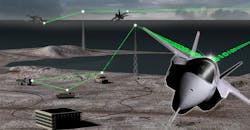Autonomy Software Aids Air Mission Planning
Complex, congested air battlespaces can challenge the most innovative air mission planning. For that reason, the U.S. Defense Advanced Research Projects Agency (DARPA) recently awarded BAE Systems a Phase 3 contract worth $3.1 million to continue developing autonomy software to improve the resiliency of air mission planning for the military. As part of the Resilient Synchronized Planning and Assessment for the Contested Environment (RSPACE) program, the software is meant to assist air mission operators to better understand and control operations in complex battlespaces.
Software being developed for DARPA’s RSPACE program will help tactical planners to more efficiently manage complex air battlespaces. (Courtesy: BAE Systems)
According to the needs of the RSPACE program, BAE Systems has created its Distributed, Interactive, Command-and-Control Tool (DIRECT) software to improve air battlespace awareness. The software analyzes battlespace data and provides an easy-to-use visual graphical user interface (GUI) to generate real-time warnings to operators about areas of concern during the planning and execution of air-based missions. The software is also designed to automatically adjust to changes in operating environments to minimize consumption of bandwidth when communications are limited and/or being jammed.
“New users have found DIRECT easy to learn, indicating we are well on our way to providing a software decision aid that will help planners adapt to plan changes, make real-time decisions faster, and more effectively execute their missions,” said Chris Eisenbies, product line director of the Autonomy, Controls, and Estimation group at BAE Systems. Work for the RSPACE program is being conducted at BAE facilities in Burlington, Mass. and Arlington, Va. and by teammate Uncharted Software, Inc.
About the Author
Jack Browne
Technical Contributor
Jack Browne, Technical Contributor, has worked in technical publishing for over 30 years. He managed the content and production of three technical journals while at the American Institute of Physics, including Medical Physics and the Journal of Vacuum Science & Technology. He has been a Publisher and Editor for Penton Media, started the firm’s Wireless Symposium & Exhibition trade show in 1993, and currently serves as Technical Contributor for that company's Microwaves & RF magazine. Browne, who holds a BS in Mathematics from City College of New York and BA degrees in English and Philosophy from Fordham University, is a member of the IEEE.


